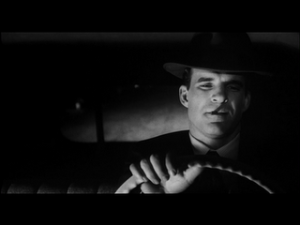Every now and then there comes a year when it seems that there are an inordinate number of really good films out in theaters. Is it the result of some sort of cultural zeitgeist or is it just mere coincidence? Who can say? But what can be known for sure is that the summer of 1982 was one of those magical movies times. On the 30th anniversary of that summer we will take a look back at some of the many movies that made that summer so memorable.
 The original plan was to include just one scene from a 1930’s film into their new project, Depression. But Steve Martin and Carl Reiner, aided by screenwriter George Gipe, couldn’t stop at just one classic Hollywood clip for their follow-up to their 1979 smash hit, The Jerk and so their comedy about the 1930s became a spoof/homage to the film noir flicks from that era and beyond–replete with footage from the greatest noir films of all time, and Depression became Dead Men Don’t Wear Plaid.
The original plan was to include just one scene from a 1930’s film into their new project, Depression. But Steve Martin and Carl Reiner, aided by screenwriter George Gipe, couldn’t stop at just one classic Hollywood clip for their follow-up to their 1979 smash hit, The Jerk and so their comedy about the 1930s became a spoof/homage to the film noir flicks from that era and beyond–replete with footage from the greatest noir films of all time, and Depression became Dead Men Don’t Wear Plaid.
It might be easy to dismiss Dead Men Don’t Wear Plaid as an entertaining trifle not worthy of serious consideration. But the comedy has an indelible place in cinematic history, not only for the movies it influenced, but for the Hollywood legends for whom the film was their last entry in their storied resume.
Reiner and Gipe were tasked with going through hours upon hours of classic noir films to try to get footage they could build their script around. Once they found enough dialogue that they could use, they built a hard-boiled mystery surrounding a private eye named Rigby Reardon (Martin) who is hired by a mysterious woman by the name of Juliet Forrest (Rachel Ward) to investigate the death of her father. The investigation uncovers a Nazi conspiracy and brings Reardon in contact with a universe of Hollywood’s most glamorous stars, ranging from Cary Grant to Kirk Douglas, from Joan Crawford to Ava Gardner.
 The film sent up the noir film trademarks–the femme fatale who can’t be trusted, the detective who falls for his client, the wise-cracking, witty dialogue–all filtered through a lens of unabashed silliness. For instance, one of the detective story staples is how the mystery is revealed. Typically, it’s either the detective revealing what he’s figured out or the bad guy explaining his plans to the captured good guy. Here, it’s both: Reardon races with the Nazi general (Reiner) to get the story out first.
The film sent up the noir film trademarks–the femme fatale who can’t be trusted, the detective who falls for his client, the wise-cracking, witty dialogue–all filtered through a lens of unabashed silliness. For instance, one of the detective story staples is how the mystery is revealed. Typically, it’s either the detective revealing what he’s figured out or the bad guy explaining his plans to the captured good guy. Here, it’s both: Reardon races with the Nazi general (Reiner) to get the story out first.
Here’s about 15 minutes of scenes from the film to give you an idea of what I am talking about:
The film was a goofy parody of the film noir genre, but also a tribute to it. This shows in the way Reiner tried to capture the look of the classic films and allow them to fit seamlessly with his new footage. There was no computer magic here. It was all done with creative editing and stand-ins wearing costumes. This is where one of the most legendary names in Hollywood history came into play.
 Legendary costume designer Edith Head was called in to costume the film, totally appropriate considering some of the films she costumed, including Double Indemnity and The Glass Key were used by Reiner in this film. If Reardon was talking to Veronica Lake in a scene taken from that latter film, Head insured that Lake’s 1980s stand-in was wearing that same dress Lake was and Steve Martin was wearing the same suit worn by the character Lake was speaking to in the original film. Now imagine doing the same thing every time Martin interacted with an actor from decades in the past and you understand why Edith Head is still recognized over 30 years after her death as the best ever in her field.
Legendary costume designer Edith Head was called in to costume the film, totally appropriate considering some of the films she costumed, including Double Indemnity and The Glass Key were used by Reiner in this film. If Reardon was talking to Veronica Lake in a scene taken from that latter film, Head insured that Lake’s 1980s stand-in was wearing that same dress Lake was and Steve Martin was wearing the same suit worn by the character Lake was speaking to in the original film. Now imagine doing the same thing every time Martin interacted with an actor from decades in the past and you understand why Edith Head is still recognized over 30 years after her death as the best ever in her field.
Dead Men Don’t Wear Plaid would prove to be Head’s last film, as she succumbed to an incurable disease of the bone marrow shortly after the film wrapped. It would also be the last feature done by Oscar-winning composer Miklós Rózsa, who, like Head, worked on many of the films the creators culled footage from. He would retire after this film, but his work on it added a sense of continuity and authenticity the parody needed. Rózsa would pass away in 1995.
We would only have to wait a year before the film’s influence was felt. Woody Allen would use blue screen technology to insert himself into archival newsreel footage in 1983’s Zelig. And over a decade later, Robert Zemeckis would use computer generated imagery to have Tom Hanks’ Forrest Gump meet everyone from JFK to John Lennon. But Dead Men Don’t Wear Plaid was the the start of the idea.
1982 is a very historic year in cinema, and there might be more films that are better remembered or of more historical import. But Dead Men Don’t Wear Plaid deserves mention in any discussion of the Summer of 1982 for the trends it set and the legacies it honored.




